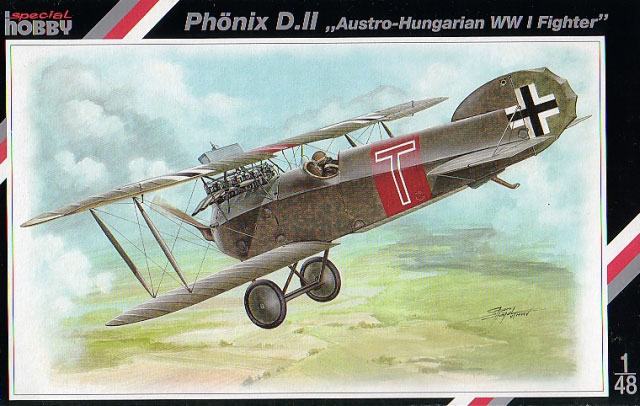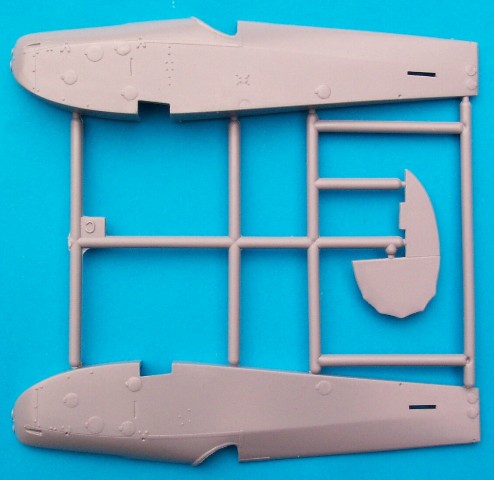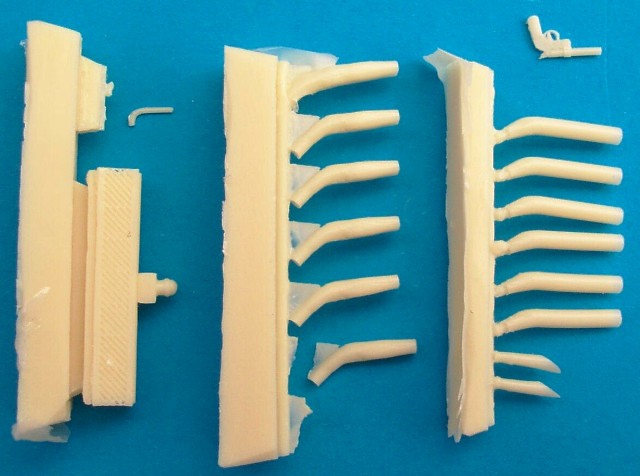|
Phönix D.II

Special Hobby, 1/48 scale
S u m m a r y
|
|
Catalogue Number: |
Special Hobby 1/48
scale Phönix D.II kit #SH48036 |
|
Scale: |
1/48 |
| Contents and
Media: |
37
parts in grey injection moulded plastic; 16 parts in yellow
resin; 1 photo etched fret; acetate film with printed
instruments; decals for
two aircraft. |
| Price: |
USD$30.96 from Squadron.com |
| Review Type: |
FirstLook |
| Advantages: |
Use of latest
published information, blemish free resin, accurate outline,
very sharp trailing edges and of course…the subject matter. |
| Disadvantages: |
Decals out of register |
|
Recommendation: |
Recommended. |
Reviewed by Rob Baumgartner

Special
Hobby's 1/48 scale Phonix D.II is available online from
Squadron.com
It was with much relief that I spied the Special Hobby release of the
Phönix D.II. Having acquired their earlier representation of the D.I, I
was keen to add this version to the stable.
Despite outward appearances, there is very little commonality between
the two kits. The main sprue is familiar but due to the different length
fuselage of the D.II, new items are provided.

Interior items remain the same as do the wheels, engine and struts. New
wings are supplied because of the different rib arrangement, and the
distinctive fin and rudder also make the necessary appearance.
There are 37 plastic parts in total and these are complimented by 16
resin items. The latter takes care of the exhausts and upper wing
radiator but the icing on the cake has to be the delightful flare
pistol. The detail was delicate and there were no casting problems on
any of the items.

Click the thumbnails below to view larger images:
A photo-etched fret caters for the seatbelts, gun sights, flare rack,
flare pistol (with mounting brace), tailplane struts, and instrument
panel. This last part is a generic arrangement and purists will no doubt
build their own. An acetate sheet allows for the dial faces and this
medium is also used for the windshields.
The outline of the major components is excellent and is based on the
latest information published in the recent JaPo book on the type. This
is good news as previous publications have maintained that both the D.I
and D.II had the same length fuselage. This reference source also points
out the different fin and rudder, which the new type demands.
Interestingly, Special Hobby decided to mould the lower wing with one
less rib inboard of the outer struts when compared to the plans in the
previously mentioned book. They do however match George Haddrow’s
general arrangements in the Windsock Datafile on the subject. A study of
contemporary photographs will have to sort matters out here.
The trailing edges of the flying surfaces are very thin and it is
commendable to see that the manufacturers have even included the
characteristic “washout” on the ailerons. The rib detail is subtle and
the sprue attachment points are such that no detail will be lost on the
removal of the parts.
A minimum of clean up time will be necessary, and the soft plastic helps
here. There is plenty of scope to add extra items to the cockpit such as
switches, throttle lever, magneto, pressure pump and the like.
The decal sheet is beautifully printed but unfortunately my example
was out of register. This included both the black on white and red on
white subjects.
The carrier film is wonderfully thin and the manufacturers should be
applauded for including both the propeller and Phönix logos. Note
though, that the supplied airscrew will require some modification to
represent a typical type attached to the aircraft in question.
Two different aircraft are made available by the decal sheet.
1. Phönix D.II, 222.10, Flick 55J, June/July
1918, Pergine airfield.
Oblt. Eduard Ritter von Hebra flew this machine and it is the subject
for which the lovely flare pistol and mount are supplied. Being a
Kettenführer he used it for signalling purposes and had it mounted
centrally on the upper wing.
On the 15th July 1918 he was shot down in this aircraft.
2. Phönix D.IIa; 422.30, Flick 14J, October/November 1918, Feltre
airfield.
This is how Fw. Karl Teichmann’s aircraft looked at the end of the
war. He scored the last of his five victories in it on 22 August 1918.
Austria was his final resting place where he died of natural causes in
1927.
The latest published information has been used to create this kit and
that makes it the most accurate Phönix D.II to date. As usual, all of
the basic elements are presented and it is up to the builder as to how
much extra detail is to be incorporated.
This is a fine release from Special Hobby and one that makes a great
companion to the previously released D.I.
Recommended
Thanks to MPM/Special Hobby for the review sample.
Review Text and Images Copyright © 2005 by Rob
Baumgartner
Page Created 17 November, 2005
Last updated 16 November, 2005
Back to HyperScale Main Page
Back to Reviews Page
|
Home | What's
New | Features
| Gallery |
Reviews | Reference
| Forum
| Search